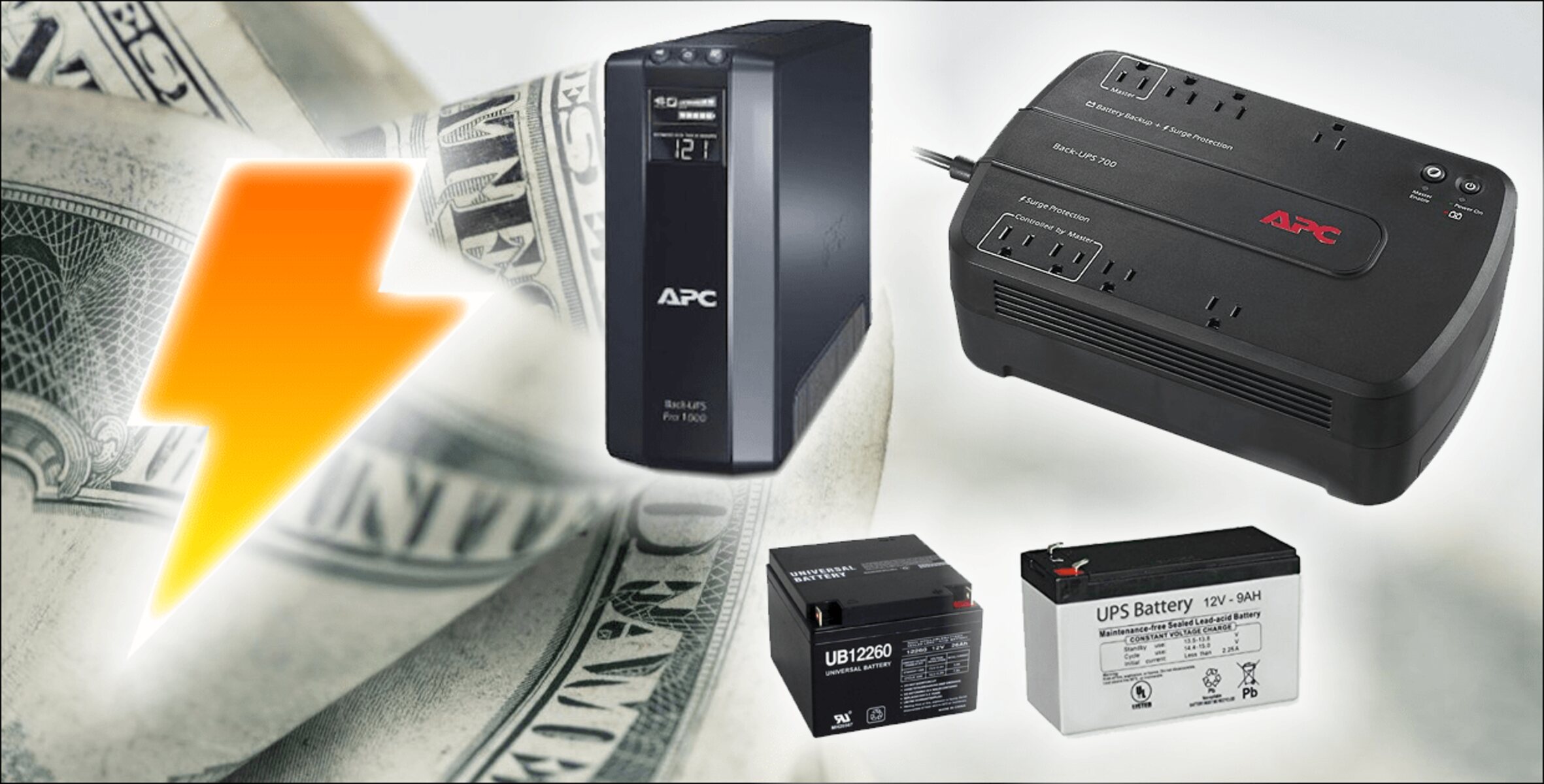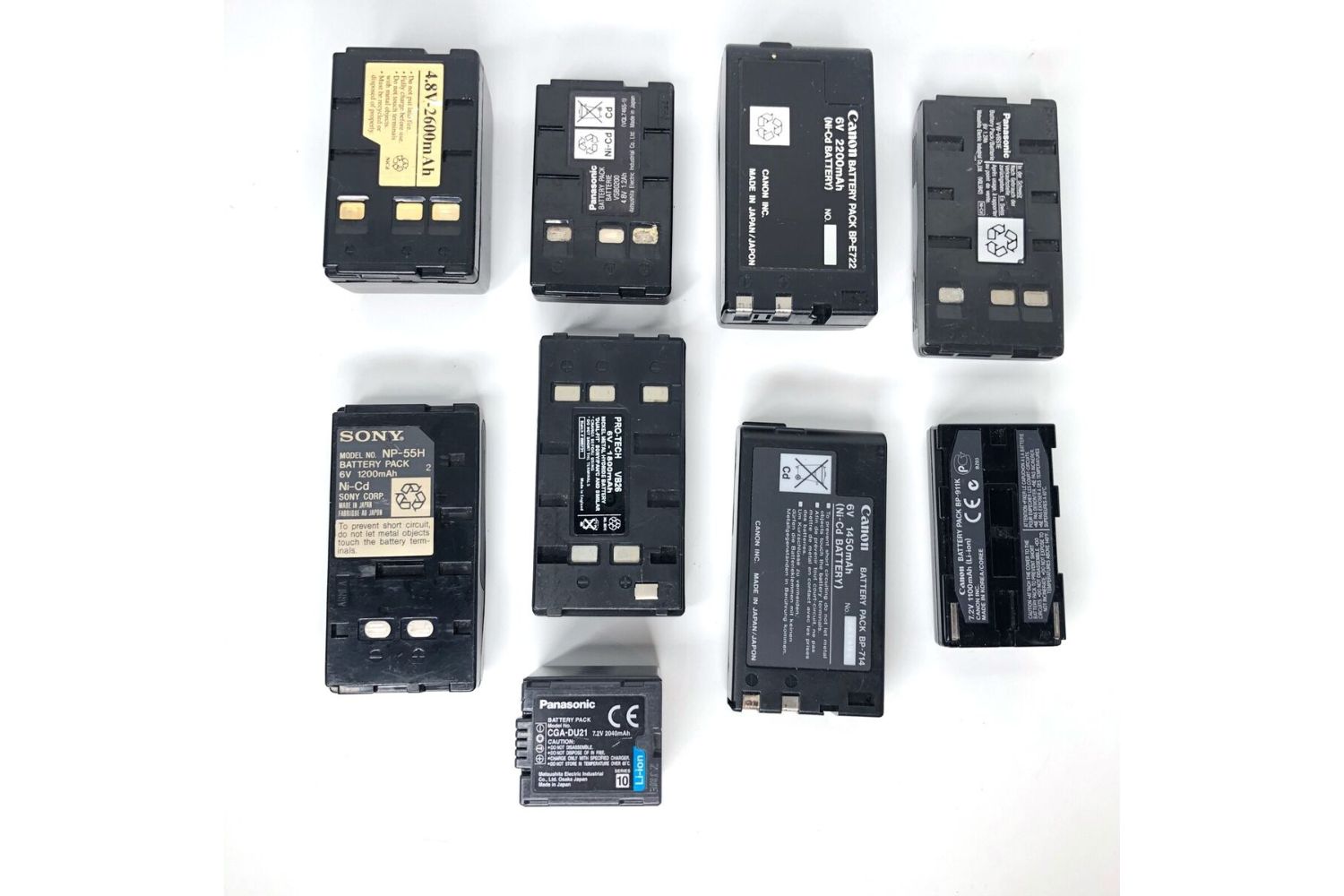Introduction
Welcome to our comprehensive guide on how to revive a UPS battery. Uninterruptible Power Supply (UPS) batteries play a vital role in providing backup power during electrical outages, ensuring the continuous operation of critical devices and equipment. However, over time, these batteries can deteriorate and lose their ability to hold a charge, resulting in a shortened lifespan and reduced efficiency.
Reviving a UPS battery is a cost-effective and environmentally-friendly alternative to replacing it entirely. By following the steps in this guide, you’ll have the opportunity to extend the life of your UPS battery and save yourself the hassle and expense of purchasing a new one.
In the sections ahead, we will walk you through the process of understanding the basics of a UPS battery, identifying the telltale signs of a dying battery, and introducing various methods you can employ to revive it. Whether you encounter a UPS battery in your home, office, or any other establishment, this guide will provide you with the necessary knowledge and techniques to bring it back to life.
Before we delve into the specifics, it’s important to note that working with batteries involves some risks, including potential electrical shock and chemical exposure. Therefore, it is crucial to follow proper safety precautions throughout the process. By adhering to these guidelines, you’ll ensure your safety and the successful revival of your UPS battery.
Now, let’s begin our journey towards reviving a UPS battery and regaining reliable power backup to keep our essential devices running smoothly.
Understanding a UPS Battery
A UPS battery, short for Uninterruptible Power Supply battery, is a crucial component in providing emergency backup power during electrical outages or disruptions. It is commonly used to protect sensitive electronic devices such as computers, servers, network equipment, and other critical systems, preventing data loss and ensuring uninterrupted operation.
UPS batteries are typically rechargeable and come in various sizes and capacities, depending on the power requirements of the devices they support. They are designed to store electrical energy and supply it to connected devices during power interruptions or unstable power conditions. When the utility power supply is disrupted, the UPS battery seamlessly takes over, providing continuous power until the main power source is restored or until the devices are safely shut down.
Most UPS batteries are made of lead-acid, sealed lead-acid (SLA), or lithium-ion (Li-ion) chemistries. Lead-acid batteries are the most commonly found type in UPS systems due to their affordability and reliability. SLA batteries use a gel or absorbent glass mat (AGM) technology, making them maintenance-free and resistant to leakage. On the other hand, Li-ion batteries offer high energy density and longer lifespan, making them ideal for UPS applications that require more power.
To further understand a UPS battery, it is important to familiarize yourself with its key components:
- Battery Housing: The external casing that houses the battery cells and provides protection.
- Battery Cells: These individual cells store the electrical energy and are connected in series to achieve the desired voltage.
- Battery Management System (BMS): The BMS is responsible for monitoring and controlling the battery’s operation, ensuring optimal performance and safety.
- Terminals: These are the connections used to interface the battery with the UPS system or other equipment.
It is essential to note that UPS batteries have a limited lifespan, typically ranging from two to five years, depending on usage and environmental factors. With time, the battery’s capacity and performance gradually decline, leading to reduced backup runtime and increased vulnerability to power disruptions.
Now that we have gained an understanding of what a UPS battery is and its essential components, let’s proceed to the next section where we will explore the signs that indicate a dying UPS battery.
Signs of a Dying UPS Battery
Over time, a UPS battery may start to show signs of deterioration and impending failure. It is important to recognize these signs to take appropriate action and prevent potential disruptions or damage to your critical equipment. Here are some common indicators that signify a dying UPS battery:
- Reduced Backup Runtime: One of the primary indications of a failing UPS battery is a noticeable decrease in the backup runtime. If you begin to experience shorter periods of backup power before the UPS shuts down, it may be a sign that the battery is losing its capacity to hold a charge.
- Constant Beeping or Alarms: Most UPS systems include audible alarms or beeping sounds to alert users of any issues or failures. If your UPS is beeping consistently or the alarm is frequently sounding, it could be indicating a problem with the battery.
- Physical Bulging or Leakage: A swollen or bulging battery pack is a clear sign of internal damage and deterioration. Additionally, any signs of leakage or corrosion on the battery casing or terminals should not be ignored and may indicate battery failure.
- Increased Charging Time: If it takes significantly longer for the UPS battery to fully charge than it used to, it may be an indication of internal wear and decreased efficiency.
- Unreliable Power Output: If your UPS system fails to provide a stable and consistent power output to connected devices or exhibits fluctuations in voltage, it could be a sign of an ailing battery.
- Foul Odor: A noticeable, unpleasant odor coming from the UPS or the battery compartment could indicate a chemical reaction or leakage, which is a clear indicator of battery failure.
It’s worth noting that these signs may not always be exclusive to a failing battery and could be caused by other factors. However, if you notice multiple indicators or experience a combination of these symptoms, it is highly likely that your UPS battery is nearing the end of its lifespan and requires attention.
By being vigilant and recognizing these signs early on, you can take proactive measures to revive or replace the battery, ensuring continuous power backup and protecting your valuable equipment from potential damage.
Now that we understand the signs of a dying UPS battery, let’s move on to the next section where we will explore essential safety precautions to keep in mind before attempting to revive the battery.
Safety Precautions
When working with UPS batteries, it is important to prioritize safety to protect yourself from potential hazards and ensure a successful battery revival process. Here are some essential safety precautions to keep in mind:
- Read and Follow the Manufacturer’s Instructions: Before attempting any maintenance or revival procedures, carefully read and understand the manufacturer’s instructions for your UPS system and battery. This will provide you with specific safety guidelines and procedures specific to your equipment.
- Disconnect Power and Devices: Before working on the UPS battery, ensure that the power supply is disconnected and any devices or equipment connected to the UPS are turned off. This will help prevent accidental shocks or damage to the equipment.
- Wear Protective Gear: Wear appropriate protective gear, such as gloves and safety glasses, to protect yourself from any potential chemical spills or exposure to hazardous materials.
- Work in a Well-Ventilated Area: Perform the battery revival procedure in a well-ventilated area to minimize the inhalation of fumes or gases that battery chemicals may emit.
- Avoid Open Flames or Sparks: Keep any open flames, sparks, or smoking materials far away from the battery as it may contain flammable components or emit flammable gases.
- Handle Batteries with Care: Be cautious when handling UPS batteries, especially if they are damaged or leaking. Avoid touching any exposed metal parts and use insulated tools when necessary.
- Dispose of Batteries Properly: If ultimately unable to revive the battery, dispose of it according to local regulations and guidelines. Many batteries contain hazardous materials and must be recycled or disposed of in specific ways to protect the environment.
Remember, safety should always be your top priority when working with UPS batteries or any electrical components. If you are unsure or uncomfortable with any aspect of the battery revival process, seek professional assistance.
Now that we understand the safety precautions involved, let’s dive into the step-by-step guide for reviving a UPS battery using various methods.
Step-by-Step Guide to Reviving a UPS Battery
Reviving a UPS battery can be done through several methods, each with its own set of steps and considerations. In this section, we will provide you with a step-by-step guide to help you revive your UPS battery successfully.
Step 1: Safety First
Prioritize safety by following the precautions mentioned in the previous section. Ensure you are working in a well-ventilated area with appropriate protective gear.
Step 2: Disconnect Power
Make sure to disconnect the UPS system from the power source and turn off any connected devices or equipment.
Step 3: Remove the Battery
Open the UPS case and carefully remove the UPS battery from its housing. Take note of the battery’s orientation, making it easier to reinsert later.
Step 4: Inspect the Battery
Thoroughly inspect the battery for any signs of physical damage, swelling, leakage, or corrosion. If the battery is severely damaged, it may not be suitable for revival and should be replaced instead.
Step 5: Discharging the Battery
If you choose the discharging and recharging method, you need to discharge the battery completely. Connect a load, such as a light bulb or resistor, to the battery terminals until the voltage drops to zero. This process can take several hours or even days, depending on the battery capacity.
Step 6: Recharging the Battery
After the battery is fully discharged, reconnect it to the UPS system and plug the UPS into an outlet. Allow the battery to recharge fully, which can take several hours or overnight. Monitor the charging process and ensure the battery is charging correctly.
Step 7: Refreshing the Battery with Epsom Salt (Optional)
If you decide to use the Epsom salt method, dissolve the appropriate amount of Epsom salt in distilled water and carefully pour it into the battery cells. Reinstall the battery in the UPS system and allow it to charge fully. Remember to follow the manufacturer’s instructions regarding the Epsom salt concentration.
Step 8: The Freezer Trick (Optional)
If you choose the freezer trick method, place the battery in a sealed plastic bag and put it in the freezer for approximately 24 hours. Afterward, let the battery thaw at room temperature for a few hours before reinstalling it into the UPS system. This method is controversial and not recommended for all types of batteries, so exercise caution.
Step 9: Using a Battery Reconditioner (Optional)
If you opt for a battery reconditioning device, follow the manufacturer’s instructions for connecting and operating the reconditioner. These devices use specific charging algorithms to revive old batteries and restore their capacity. Allow the reconditioning process to complete fully before reconnecting the battery to the UPS system.
Step 10: Replacing the Battery Cells (Advanced)
If all other methods fail, you can attempt to replace individual battery cells. This method requires more advanced knowledge and should only be done if you are confident in your abilities to handle batteries safely. Consult the UPS system and battery manufacturer’s documentation for instructions on cell replacement.
Remember to reassemble the UPS system carefully and properly reconnect any cables or connections. Test the revived battery by reconnecting the power source and running a test on the connected devices to ensure their smooth operation.
With each method, monitor the revived battery’s performance and observe for any signs of improvement or deterioration in backup performance. If the battery’s condition does not improve or worsens over time, it may be time to consider replacing it.
Now that you have a step-by-step guide for reviving a UPS battery, you’re equipped with the knowledge to make an informed decision and take the necessary actions to bring your UPS battery back to life.
Method 1: Discharging and Recharging the Battery
One of the common methods for reviving a UPS battery is by discharging and recharging it. This process helps to remove any memory effect and recalibrate the battery’s capacity. Here’s a step-by-step guide on how to discharge and recharge a UPS battery:
Step 1: Safety Precautions
Follow the safety precautions mentioned earlier in this guide to ensure your well-being and prevent any accidents during the process.
Step 2: Disconnect Power
Make sure to disconnect the UPS system from the power source and turn off any devices or equipment connected to it.
Step 3: Remove the Battery
Open the UPS case, locate the battery, and carefully remove it from its housing, taking note of its orientation for reinstallation.
Step 4: Discharge the Battery
Connect a load, such as a light bulb or resistor, to the battery terminals to slowly discharge it. Monitor the voltage using a multimeter until it reaches zero. This process can take several hours or even days, depending on the battery’s capacity and charge.
Step 5: Recharge the Battery
After the battery is fully discharged, reconnect it to the UPS system and plug the UPS into a power outlet. Allow the battery to recharge fully, which can take several hours or overnight. Monitor the charging process and ensure the battery is charging correctly without any abnormal heat or leakage.
Step 6: Test and Monitor
After the battery is fully charged, reinsert it into the UPS system, reassemble the case, and reconnect any cables or connections. Test the revived battery by reconnecting the power source and running a test on the connected devices to ensure their smooth operation. Monitor the battery’s performance over time to ensure it remains reliable.
It’s important to note that this method may not work for all cases of battery degradation. Factors such as the battery’s age, condition, and type may influence the effectiveness of this method. If the battery does not show any improvement or continues to exhibit reduced backup runtime, you may need to explore alternative methods or consider replacing the battery altogether.
By following this step-by-step guide, you have the opportunity to revive your UPS battery and extend its lifespan. Remember to exercise patience and caution during the discharging and recharging process, as mishandling batteries can result in damage or injury.
In the following sections, we will explore additional methods you can attempt to revive a UPS battery, providing you with a range of options to suit your specific situation and battery condition.
Method 2: Refreshing the Battery with Epsom Salt
Another method for reviving a UPS battery is by refreshing it with Epsom salt. Epsom salt, also known as magnesium sulfate, can help restore the performance and extend the lifespan of certain types of batteries. Here’s a step-by-step guide on how to refresh a UPS battery with Epsom salt:
Step 1: Safety Precautions
As always, prioritize safety by following the precautionary measures mentioned earlier in this guide. Wear gloves and safety glasses to protect yourself from any potential chemical spills or exposure.
Step 2: Disconnect Power
Ensure that the UPS system is disconnected from the power source and that any devices or equipment connected to it are turned off.
Step 3: Remove the Battery
Open the UPS case and carefully remove the UPS battery from its housing, paying attention to its orientation for reinsertion.
Step 4: Prepare the Epsom Salt Solution
In a clean container, dissolve the appropriate amount of Epsom salt in distilled water. The ideal concentration may vary depending on the battery type and size. Consult the battery manufacturer’s documentation or online resources for specific instructions regarding Epsom salt concentration.
Step 5: Pour the Solution into the Battery Cells
Using a funnel or syringe, carefully pour the Epsom salt solution into each battery cell. Ensure that the level of the solution does not exceed the recommended maximum level indicated by the manufacturer.
Step 6: Reinstall the Battery
After pouring the solution, reinstall the battery back into the UPS system, taking care to align it correctly. Ensure that the battery terminals are securely connected to their respective terminals in the UPS.
Step 7: Recharge the Battery
Plug the UPS system into a power outlet and allow the battery to recharge fully. The charging process may take several hours or overnight. Monitor the charging process and ensure the battery is charging correctly without any abnormal heat or leakage.
Step 8: Test and Monitor
Once the battery is fully charged, reassemble the UPS case and reconnect any cables or connections. Test the revived battery by reconnecting the power source and running a test on the connected devices to ensure their smooth operation. Monitor the battery’s performance over time to evaluate its effectiveness.
It’s important to note that the Epsom salt method may not work for all types of batteries, and its effectiveness may vary. Additionally, improper handling or excessive use of Epsom salt can potentially damage the battery or reduce its lifespan. If the battery does not show any improvement or experiences further degradation, you may need to explore alternative methods or consider battery replacement.
By following this step-by-step guide, you have the opportunity to refresh your UPS battery using Epsom salt and potentially extend its life. Remember to exercise caution, follow the manufacturer’s guidelines, and monitor the battery’s performance throughout the process.
In the next section, we will explore another method that involves using the freezer as a potential solution for reviving a UPS battery.
Method 3: The Freezer Trick
Another method that some people have used to revive a UPS battery is called “the freezer trick.” This method involves placing the battery in a sealed plastic bag and freezing it for a period of time. While this method is controversial and not recommended for all types of batteries, it has been reported to offer varying degrees of success in certain cases. Here’s a step-by-step guide on how to attempt the freezer trick:
Step 1: Safety Precautions
As always, prioritize safety by following the precautionary measures mentioned earlier in this guide. Wear gloves and handle the battery with care to avoid any potential accidents or injuries.
Step 2: Disconnect Power and Remove the Battery
Make sure to disconnect the UPS system from the power source and turn off any devices or equipment connected to it. Open the UPS case and carefully remove the battery, paying attention to its orientation for reinstallation.
Step 3: Seal the Battery in a Plastic Bag
Place the battery in a sealable plastic bag, ensuring that it is completely sealed and airtight. This step helps protect the battery from moisture during the freezing process.
Step 4: Freeze the Battery
Place the sealed bag containing the battery in the freezer and leave it there for approximately 24 hours. It is important to note that different sources may recommend varying durations, so it is best to research and follow the recommendations specific to your battery and its chemistry.
Step 5: Thaw the Battery
After freezing the battery, remove it from the freezer and let it thaw at room temperature for a few hours. This allows the battery to gradually return to its normal operating temperature.
Step 6: Reinstall the Battery
Once the battery has thawed, reinstall it back into the UPS system, ensuring proper alignment and secure connections.
Step 7: Recharge the Battery
Plug the UPS system into a power outlet and allow the battery to recharge fully. Monitor the charging process to ensure it is proceeding correctly.
Step 8: Test and Monitor
Reassemble the UPS case and reconnect any cables or connections. Test the revived battery by reconnecting the power source and running a test on the connected devices to evaluate its performance. Monitor the battery’s operation over time to determine if the freezer trick has had a positive impact on its revival.
It’s important to note that the freezer trick is not universally recommended and may not work for all types of batteries. Some battery manufacturers and experts caution against this method, as freezing can potentially cause damage to the battery’s internal components or accelerate degradation if not done correctly. Additionally, this method is typically recommended for lead-acid or certain types of laptop batteries, and it is not suitable for all battery chemistries.
Proceeding with caution and thoroughly researching the specific recommendations and risks associated with your battery type is crucial when attempting the freezer trick. If the battery does not show any improvement or exhibits further deterioration, it may be necessary to explore alternative methods or consider battery replacement.
In the next section, we will explore the use of a battery reconditioner as another potential method for reviving a UPS battery.
Method 4: Using a Battery Reconditioner
If other methods have failed to revive your UPS battery, using a battery reconditioner may be worth considering. A battery reconditioner is a device specifically designed to restore and rejuvenate degraded batteries by employing advanced charging algorithms. Here’s a step-by-step guide on how to use a battery reconditioner to revive a UPS battery:
Step 1: Safety Precautions
Always prioritize safety by following the precautionary measures mentioned earlier in this guide. Wear gloves and safety glasses to protect yourself during the battery reconditioning process.
Step 2: Disconnect Power and Remove the Battery
Disconnect the UPS system from the power source and turn off any connected devices or equipment. Open the UPS case and carefully remove the battery, noting its orientation for reinstallation later.
Step 3: Connect the Battery Reconditioner
Follow the instructions provided by the manufacturer of the battery reconditioner to properly connect it to the battery terminals. Ensure a secure and correct connection to prevent any damage to the battery or the reconditioner.
Step 4: Start the Reconditioning Process
Turn on the battery reconditioner and initiate the reconditioning process according to the device’s instructions. The reconditioner will employ specific charging algorithms designed to restore the battery’s capacity and performance.
Step 5: Monitor the Reconditioning Process
Closely monitor the battery reconditioning process, ensuring that the battery and the reconditioner are operating at safe temperatures. Follow the manufacturer’s instructions regarding duration and any specific requirements during the process.
Step 6: Recharge and Test the Battery
After the reconditioning process is complete, disconnect the battery reconditioner and reconnect the battery to the UPS system. Plug the UPS into an outlet and allow the battery to recharge fully. Test the revived battery by running a test on the connected devices to assess its performance.
Step 7: Monitor the Battery’s Performance
Observe the battery’s performance over time to determine if the reconditioning process has been successful in restoring its capacity and prolonging its lifespan. Regularly monitor its backup runtime and overall reliability to ensure optimal performance.
It’s important to note that not all UPS batteries are suitable for reconditioning, and the effectiveness can vary depending on the battery’s age, chemistry, and overall condition. Additionally, some battery reconditioners may be designed for specific battery types or sizes, so it’s crucial to choose a reconditioner that is compatible with your battery.
If the battery does not show significant improvement after using a battery reconditioner or its performance continues to decline, it may be necessary to consider alternative methods or replace the battery altogether.
In the next section, we will explore another method that involves replacing the individual battery cells as a potential solution for reviving a UPS battery.
Method 5: Replacing the Battery Cells
If all other methods have proven unsuccessful in reviving your UPS battery, you may consider replacing the individual battery cells. This method requires more advanced knowledge and skill in handling batteries, but it can be a cost-effective option compared to replacing the entire battery. Here’s a step-by-step guide on how to replace the battery cells in a UPS battery:
Step 1: Safety Precautions
Always prioritize safety by following the precautionary measures mentioned earlier in this guide. Wear gloves and safety glasses to protect yourself during the cell replacement process.
Step 2: Disconnect Power and Remove the Battery
Disconnect the UPS system from the power source and turn off any connected devices or equipment. Open the UPS case and carefully remove the battery, noting its orientation for reinstallation later.
Step 3: Identify the Faulty Cells
Inspect the battery to identify the specific cells that are causing the degradation. Look for signs of physical damage, swelling, or leakage. Use a multimeter to test the voltage of each individual cell to pinpoint the faulty ones.
Step 4: Remove the Faulty Cells
Using appropriate tools, carefully disconnect the wiring and remove the faulty battery cells from the battery housing. Take note of the wiring connections and cell positioning for accurate reinstallation later.
Step 5: Purchase Replacement Cells
Identify the correct replacement cells for your UPS battery. Ensure that they are of the same type, voltage, and capacity as the original cells. Purchase the replacement cells from a reputable supplier or manufacturer.
Step 6: Install the Replacement Cells
Position the replacement cells in the battery housing, aligning them correctly with the wiring connections. Reconnect the wiring to each cell, ensuring a secure and proper connection without any misalignment or short circuits.
Step 7: Reassemble the Battery
Carefully place the reconnected cells back into the battery housing. Ensure that they are properly aligned and securely seated. Reassemble the battery by closing the battery housing and securing it according to the manufacturer’s instructions.
Step 8: Recharge and Test the Battery
Reconnect the battery to the UPS system, plugging the UPS into an outlet. Allow the battery to recharge fully. Test the revived battery by running a test on the connected devices to evaluate its performance. Monitor the battery’s operation over time to ensure its reliability.
It’s important to note that replacing individual battery cells requires advanced knowledge and skills in working with batteries. If you are uncertain about your abilities to safely perform the cell replacement, consider consulting a professional or seeking assistance.
If the battery continues to exhibit poor performance or further degradation even after replacing the faulty cells, it may be necessary to explore alternative methods or consider replacing the entire battery.
In the next section, we will conclude our guide on reviving UPS batteries and provide some final thoughts on the importance of regular maintenance and battery care.
Conclusion
Reviving a UPS battery can offer a cost-effective and environmentally-friendly alternative to replacing the entire battery. By following the methods outlined in this guide, you have the opportunity to extend the life of your UPS battery and ensure reliable backup power for your critical devices and equipment.
Throughout this guide, we discussed the importance of understanding a UPS battery’s basics and recognizing the signs of a dying battery. We also emphasized the need for safety precautions while working with batteries and provided step-by-step guides for various revival methods, including discharging and recharging the battery, refreshing it with Epsom salt, trying the freezer trick, utilizing a battery reconditioner, and replacing the battery cells.
It’s important to remember that not all methods may be suitable for every type of UPS battery, and results may vary depending on the battery’s condition, age, and chemistry. It’s crucial to research, read manufacturer instructions, and exercise caution throughout the process.
In addition to trying these revival methods, it’s essential to incorporate regular maintenance and battery care practices to prolong the lifespan of your UPS battery. Regularly testing the battery’s backup performance, monitoring its condition, and ensuring it is kept in a cool and dry environment can significantly contribute to its longevity.
If your attempts to revive the UPS battery are unsuccessful or the battery’s performance continues to deteriorate, it may be time to consider replacing it. Be sure to follow proper recycling and disposal procedures for used batteries to protect the environment.
Remember, the information provided in this guide should serve as a reference and starting point for reviving a UPS battery. It’s recommended to consult the UPS system and battery manufacturer’s documentation, seek professional assistance when needed, and ensure compliance with relevant safety standards and regulations.
We hope this guide has equipped you with the knowledge and techniques to revive your UPS battery successfully. By doing so, you can enjoy uninterrupted power backup and continue to protect your valuable devices and critical systems.
Thank you for reading, and best of luck in revitalizing your UPS battery!

























